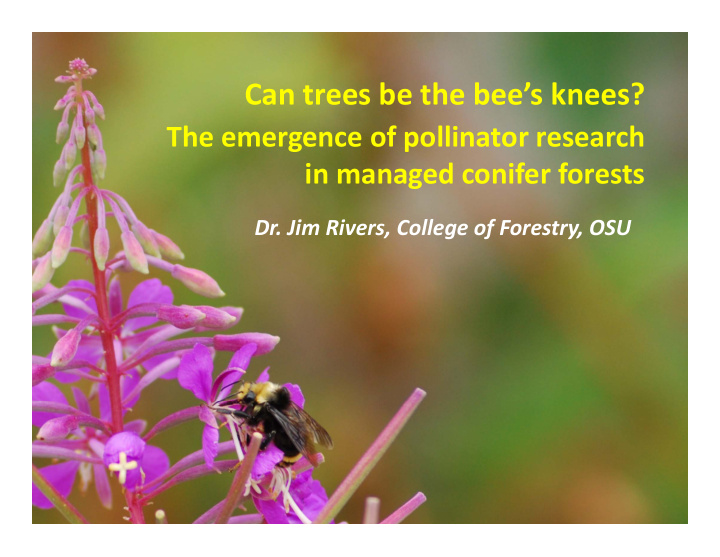



Can trees be the bee’s knees? The emergence of pollinator research in managed conifer forests Dr. Jim Rivers, College of Forestry, OSU
Three focal points for this morning The global importance of pollinators Ecology and natural history of native bees Emerging research in managed conifer forests
A refresher on animal ‐ mediated pollination
nectar housed in nectary pollen housed in anthers
Pollinators impact natural ecosystems and global food security ~75% of crops benefit >300,000 species of flowering from pollinators plants benefit from pollinators OperationBee.com
Kevin Frayer/Getty Images
Recent actions to protect pollinators and their habitats 8 bee species now listed under the ESA Johanna James ‐ Heinz
Ecology and natural history of native bees
OR Dept. Agriculture
There are >500 named species of native bees in Oregon OR Dept. Agriculture
The honey bee is atypical when it comes to bees Honey bee ( Apis mellifera ) Mining bees ( Andrena spp.) Social nesters Solitary nesters Nests in cavities (hives) Nests in the ground Adults active year ‐ round Adults active 3 ‐ 6 weeks Floral generalists Many floral specialists OR Dept. Agriculture
Arctic lupine ( Lupinus latifolius )
Trailing snowberry ( Symphoricarpos hesperius )
Salal ( Gaultheria shallon )
Mechanical disturbance can provide access to soil for ground ‐ nesting bees
Cavities provide nesting sites for many bee species Blue orchard bee ( Osmia lignaria )
Emerging pollinator research in managed conifer forests
How do natural disturbances structure pollinator communities?
How do forest management practices influence pollinators? 4 years post ‐ harvest
15 years post ‐ harvest Scott Harris
Bee numbers and species decrease with time since harvest during the early ‐ successional period 600 35 Bee species richness Number of bee species Number of bees 30 500 Bee abundance 25 400 20 300 15 200 10 5 100 0 0 0 2 4 6 8 10 12 14 16 0 2 4 6 8 10 12 14 16 Years since harvest Years since harvest Rivers and Betts, unpublished data
How does herbicide application intensity alter pollinator communities?
Pollinator number and species decrease with increased herbicide application intensity Number of pollinator species Pollinator species richness 60 24 Pollinator abundance 22 Number of pollinators 50 20 18 40 16 30 14 12 20 10 8 10 6 0 4 Control Moderate Control Moderate Herbicide intensity Herbicide intensity Management intensity Management intensity Kormann et al., unpublished data
Do bees from early ‐ successional forests pollinate adjacent agricultural crops?
Three focal points for this morning The global importance of pollinators They are critical for healthy (forest) ecosystems Ecology and natural history of native bees Bees excel at pollination via foraging activities Emerging research in managed conifer forests Many new and ongoing studies…stay tuned!
Many thanks to… Sara Galbraith Jim Cane Andy Moldenke Matt Betts Funding Bureau of Land Management; USDA AFRI; Mealey/Boise Cascade/Boone and Crockett/Noble Endowment Fun at Oregon State University; College Forests at Oregon State University; Fish and Wildlife in Managed Forests Program at Oregon State University; Native Plant Society of Oregon; Katherine Bisbee II Fund of the Oregon Community Foundation Logistical support N. Meehan, S. Holub, G. Johnson, K. Emmons, N. Garlick, I. Lively, T. Squires, K. Wright, Weyerhaeuser, Hancock, Oregon Dept. Forestry
Resources for learning about bees in Oregon and beyond http://blogs.oregonstate.edu/beeproject/
Recommend
More recommend